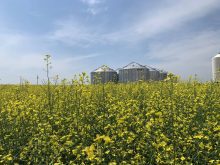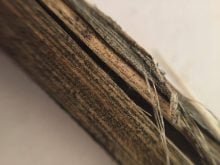There’s good news on the horizon for growers and agronomists wrestling with sclerotinia in canola.
Researchers with Agriculture and Agri-Food Canada (AAFC) have identified several canola lines with more-robust resistance to sclerotinia. They’ve also learned more about the sclerotinia pathogen and the sclerotinia resistance genes found in some canola lines.
Researchers screened nearly 500 Brassica napus germplasm lines from around the world and found about 30 lines with partial resistance to sclerotinia, says Lone Buchwaldt, plant pathology researcher with AAFC. The most resistant germplasm originated from Pakistan, South Korea and Japan, she adds. Four of these lines are now available to all canola breeders to cross into hybrids.
Read Also

Claas brings 1000 Series SP forage harvesters to Canada
In mid-August, Claas unveiled its new line of Jaguar forage harvesters at an event in Visalia, California, deep in the heart of that state’s dairy region.
- Read more: Measuring sclerotinia resistance
Buchwaldt describes Pioneer’s line as the first generation of sclerotinia resistance, with low partial resistance. “But the materials from AAFC, I believe, will become the second generation with higher partial resistance.”
So just how good are these new lines?
Researchers evaluate sclerotinia resistance using a stem test, which mimics the natural sclerotinia infection in canola. After plants are infected, researchers measure lesion length and evaluate stem collapse.
The most-resistant new lines have stem lesions less than 20 mm (3/4″) long. Stem collapse is under 10 per cent. In susceptible lines, researchers find lesions longer than 100 mm (4.0”), and stem collapse tops 75 per cent. These plants suffer severe yield loss caused by wilting, lodging, and stem breakage as the pathogen destroys vascular tissue that moves water and nutrients.

Buchwaldt has also been working with AAFC’s Sally Vail to transfer sclerotinia resistance into a spring variety with good canola quality. They selected a line from Pakistan, which has the highest sclerotinia resistance, and crossed it with one of AAFC’s elite breeding lines.
Using molecular markers linked to sclerotinia resistance, they then selected suitable F1 plants. Buchwaldt says they’ve developed a large population of double haploid lines. About 15 per cent of those plants are sclerotinia resistant, which indicates the sclerotinia resistance can be crossed into canola.
The original Pakistan line has high erucic acid and glucosinolate levels, and is late-flowering, Buchwaldt says. “But we have had no problem selecting resistance in early-maturing lines with good canola quality.”
The new variety will be open-pollinated, so breeders can use it to develop hybrids. AAFC will license that variety to interested breeders once the project wraps in 2018.
Mapping resistance genes and sclerotinia groups
Buchwaldt and her colleagues have also been studying the sclerotinia pathogen itself. They’ve analyzed the DNA of sclerotinia collected in the three Prairie provinces and grouped the pathogen into 17 isolates, or subpopulations.
Researchers then inoculated resistant canola lines with those sclerotinia isolates to measure the pathogen’s aggressiveness. Some isolates were highly aggressive, and others not. Canola breeders can now use those 17 isolates to screen their own breeding lines against sclerotinia.
Buchwaldt and colleagues also used the stem test to “identify a DNA fingerprint associated with the resistance trait” in canola. These molecular markers will be available to canola breeders in 2018.
The genetics of resistance
The most-common blackleg resistance gene in canola varieties is losing its effectiveness in some areas. Much of the blackleg resistance comes from that single gene. That puts more selection pressure on blackleg. Over time mutations in the blackleg population get around the resistance gene.
But Buchwaldt doesn’t think the sclerotinia-resistant varieties face the same risk. That’s because the partially resistant lines have several genes that work together to confer resistance. It’s unlikely the sclerotinia population will evolve to overcome those resistance genes.
What exactly makes the new high partially resistant material better at fending off sclerotinia infections? Buchwaldt analyzed the genomic variation within several resistant and susceptible Brassica napus lines. The resistant lines shared many the defence genes. But some of the high partially resistant lines had unique defence genes.
She also suspects gene regulation is better in the high partially resistant lines than the low partially resistant lines. This makes the resistance more effective. “It comes on sooner, at a higher level.”
The 17 sclerotinia isolates and the germplasm lines from Pakistan, South Korea and Japan are free. There will likely be a cost for the open-pollinated line, but that has yet to be determined.
Canola breeders interested in accessing the resources mentioned in this article can contact Lone Buchwaldt ([email protected]) or Todd Olson ([email protected]) with AAFC in Saskatoon.
















